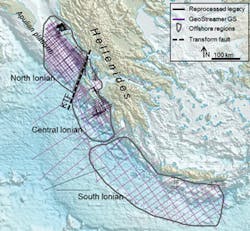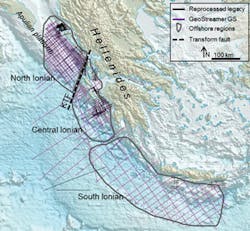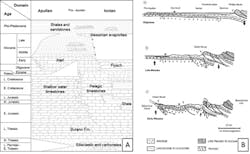Mari Schjeldsøe Berg
Jörn Fürstenau
Petroleum Geo-Services
Spyridon Bellas
YPEKA
Exploration inGreece is gaining momentum. After the 2012 open-door tender process and last year's awards in the three bid areas of western Greece (Ioannina, Gulf of Patraikos, and Katakolon), the Greek Ministry of Environment, Energy, and Climate Change (YPEKA) is expected to announce an international licensing round for hydrocarbon exploration and development, starting in September 2014. In preparation for this, an international invitation for a non-exclusive regional 2D seismic survey offshore western and southern Greece was made. This work was awarded to PGS, and the data was shot using GeoStreamer with GeoSource, producing 12,500 line km (7,767 mi) of data. The data is processed and available for licensing.
GeoStreamer with GeoSource is PGS' ghost-free broadband solution, which provides the interpreter with a clearer image of the subsurface. Offshore Greece, this is particularly crucial when imaging the prospective Mesozoic carbonate succession, allowing greater depth penetration and imaging of the structures deeper in the section than previously possible, while resolving structural details of the shallow clastic intervals. The combination of this newseismic dataset with the reprocessed legacy data allows a confident evaluation of the complex interplay and dynamics of evaporites, carbonates, and clastics, from foreland settings in western Greece to the fore-arc region south of Crete.
Past exploration offshore Greece
Exploration offshore western Greece has been stagnant over the past decade, with the last seismic survey acquired in 2000 and the last offshore well drilled in the 1980s. However, interest is growing again. No major discovery has been made, but two-thirds of the wells drilled offshore have shown traces of hydrocarbons, and seeps are abundant onshore Zakynthos and Peloponnese.
Neighboring Italy and Albania are petroliferous regions. On the Italian side, several discoveries (e.g. Falco, Giove, and Rovesti) have been made on the eastern slope of the Apulian platform and on the platform itself. This trend is understood to extend into the North Ionian region. Similarly, the Ionian zone in Greece – a geotectonic zone related to the Hellenides – extends northwards into Albania, which contains the largest onshore oilfield in Europe, the Patos-Marinza field. The main source rocks in both areas are of Triassic age and presumably equivalent to the Burano formation, also found onshore Greece.
Geological setting
The offshore region of western Greece is on the western rim of the Hellenides, a west/southwest moving fold-and-thrust belt developed since the Late Cretaceous as a result of convergence and collision between the Eurasian and African plates. It is the eastern end of the Peri-Adriatic orogenic belt extending from the Maghrebides in Tunisia. The geotectonic zones originated when the southern Tethys margin underwent rifting during the late Mesozoic, creating a platform (i.e. Apulian platform) and basin (i.e. Ionian zone) configuration, where the present day Paxi zone was the transitional slope from platform to basin. The offshore western Greece region covers the un-deformed Apulian platform and the external Hellenides, which includes the outermost Ionian and Paxi (or Pre-Apulian) geotectonic zones. As the convergence continued, the Hellenides started growing from east to west, with thrusts' age getting progressively younger toward the west/southwest, and emplacing the zones onto the stable Apulian platform.
The stratigraphy of the external Hellenides is dominated by Late Permian shelf clastics, Triassic evaporites and dolomites, and Early Mesozoic shallow-water carbonates. As the rifting of the southern Tethys margin continued, the Ionian zone was dominated by deepwater carbonates and inter-fingering shale layers, whereas the shallow-water carbonates continued to dominate the Apulian platform.
With the onset of convergence, the newly active Pindos thrust in the east created a foreland basin along its western edge. The Ionian zone was affected by the flysch deposits coming into the foreland from latest Eocene times and onwards, thus stopping the carbonate production. The Apulian platform was too distal relative to the thrust front and was not influenced by clastic input, therefore carbonate production continued until the Messinian. With the re-flooding of the Mediterranean Sea after the Messinian salinity crisis, the Apulian platform was drowned and the dominant sedimentation east of the platform since then has been hemipelagic sediments and clastic input from the erosion of the younger Ionian thrusted rocks in the east.
Seismic data
The PGS data available for the licensing round includes the 12,500 line km of new 2D fully deghosted broadband seismic and gravity-magnetic data taken offshore western and southern Greece. Additionally, 9,000 line km (5,592 mi) of reprocessed legacy seismic data have been made available, together with a select number of wells.
Displaying 1/2 Page 1,2, Next>
View Article as Single page





